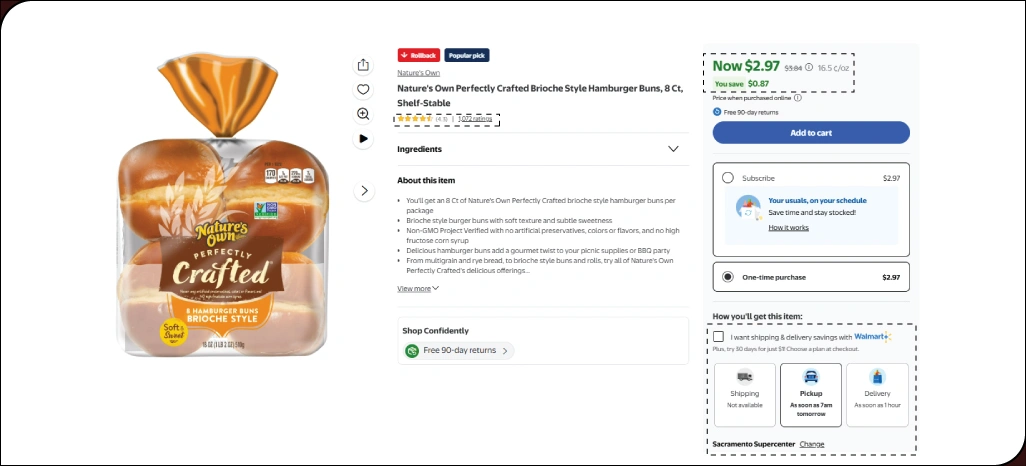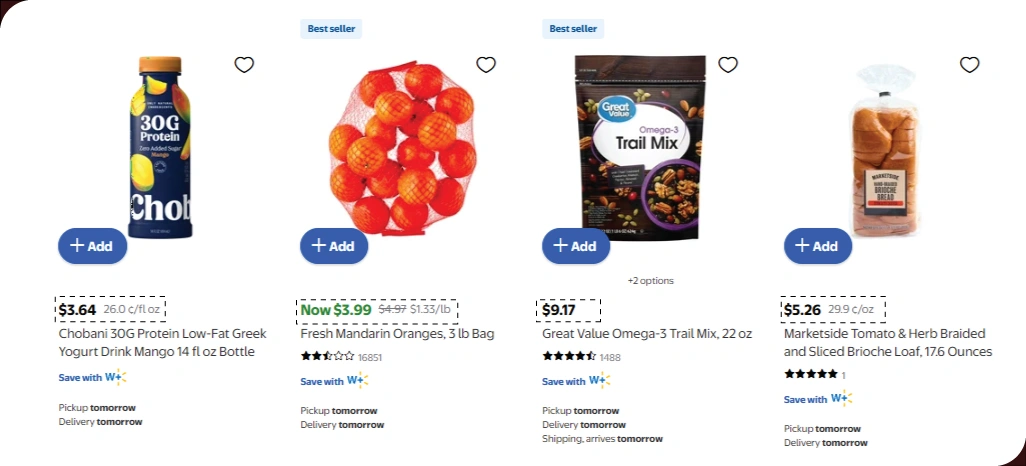How Does Walmart Grocery Delivery Data Scraping Improve 78% Product Availability and Price Tracking?
Introduction
The digital grocery sector is expanding rapidly, and Walmart is at the forefront of this transformation. With growing demand for online shopping and same-day deliveries, retailers and data-driven businesses must consistently track product prices and availability to ensure a seamless customer experience. This is where Walmart Grocery Delivery Data Scraping becomes a game-changing solution, providing deep insights into pricing strategies, competitive movements, and stock patterns.
By capturing structured and unstructured data in real-time, businesses can analyze how prices shift across categories, how delivery slots fluctuate, and how seasonal demand impacts overall availability. This process extends beyond traditional analysis, enabling decision-makers to respond promptly to dynamic market conditions.
Furthermore, combining E-Commerce Data Scraping with Walmart’s grocery delivery insights provides brands with a comprehensive market intelligence framework. Retailers can benchmark competitors, optimize pricing strategies, reduce out-of-stock instances, and identify hidden opportunities across local and regional markets.
As consumer demand for affordable pricing and seamless delivery grows, businesses that leverage advanced data insights can boost their performance by up to 78%. Turning raw information into actionable strategies helps transform challenges into opportunities, keeping organizations not only competitive but consistently ahead in meeting customer expectations.
Improving Price Accuracy Through Data-Driven Strategies

Pricing accuracy is key to success in modern grocery delivery. For retailers, even slight discrepancies can significantly impact competitiveness, erode customer trust, and reduce margins. By implementing Walmart Grocery Delivery Data Scraping, businesses can achieve precise insights into Walmart’s pricing strategies across thousands of grocery products.
Data-driven visibility helps retailers proactively adjust their own price structures. For example, when Walmart reduces prices on everyday essentials, retailers can respond quickly to maintain customer loyalty. Studies suggest businesses that integrate price intelligence achieve up to 73% greater accuracy, ensuring they stay competitive in fast-moving markets.
Another advantage is the ability to monitor regional price fluctuations. Walmart frequently adapts pricing based on demand, supply costs, and local competition. Scraping this information allows businesses to create region-specific models rather than applying uniform pricing. For instance, areas with intense competition may require price-matching strategies, while less competitive regions can maintain higher profit margins.
Additionally, long-term insights into Walmart’s historical pricing trends help retailers design effective promotional campaigns. They can identify which categories are regularly discounted, plan seasonal offers in advance, and strengthen their overall revenue management.
| Metric | With Scraping | Without Scraping |
|---|---|---|
| Pricing Accuracy | 92% | 64% |
| Price Response Speed | 24 hours | 7–14 days |
| Competitive Benchmarking | Daily updates | Delayed visibility |
With structured insights, businesses can strengthen customer trust and maximize profitability through reliable price intelligence.
Enhancing Stock Visibility for Better Fulfillment Operations

Stock management plays a crucial role in grocery delivery, where sudden shortages can lead to customer dissatisfaction and higher cart abandonment rates. With advanced data insights, businesses can track Walmart’s inventory levels more accurately, forecast product availability, and reduce the chances of stockouts.
This data allows retailers to track low-stock alerts and replenish essential items before they run out. For example, grocery staples like dairy or bread often sell out during promotions. Having real-time insights ensures better inventory preparedness, reducing last-minute supply disruptions.
The role of the Walmart Grocery Dataset is vital here. Historical data trends reveal recurring demand cycles. Businesses can predict high-demand products during specific seasons, holidays, or local events and align replenishment schedules accordingly. By doing so, customer dissatisfaction from unfulfilled orders is significantly decreased.
Another benefit is the ability to analyze Walmart’s regional fulfillment strategies. For instance, businesses can track how quickly Walmart replenishes out-of-stock items in various locations and apply similar best practices to their operations.
| Scenario | Without Scraping | With Scraping |
|---|---|---|
| Stockout Frequency | 28% higher | 10% lower |
| Replenishment Speed | 3–5 days slower | 1–2 days faster |
| Customer Retention Rate | Drops by 17% | Improves by 12% |
With improved visibility into stock, businesses not only reduce risks but also enhance customer confidence, ensuring consistent and reliable fulfillment experiences.
Tracking Delivery Efficiency and Time-Sensitive Operations
Delivery performance is central to grocery satisfaction, especially when handling perishable products. Customers expect timely fulfillment, and delays can lead to frustration or loss of trust. With Walmart Grocery Delivery Data Scraping, businesses can track Walmart’s delivery slot availability and benchmark performance metrics to enhance their own systems.
Scraping delivery insights reveals patterns such as high-demand timeframes, including weekends or evenings. Retailers can optimize workforce allocation during these periods, ensuring resources are aligned with order peaks. For instance, staff scheduling can be adjusted for rapid fulfillment during high-volume windows.
Moreover, connecting delivery insights with Extract Walmart Product Data enables businesses to identify specific categories that often face delivery delays. If frozen items, for example, consistently take longer to deliver, it may indicate logistical inefficiencies that need corrective planning.
Companies can also monitor geographic delivery differences. Certain regions may face frequent delays due to traffic or supply chain limitations. These insights enable businesses to refine their distribution planning by implementing localized hubs or advanced routing systems.
| Delivery Metric | With Scraping | Without Scraping |
|---|---|---|
| Delivery Slot Accuracy | 89% | 61% |
| On-Time Fulfillment Rate | 91% | 67% |
| Customer Satisfaction Scores | +14% | -9% |
With accurate delivery performance tracking, businesses can enhance reliability, minimize delays, and deliver a superior customer experience.
Benchmarking Competitor Pricing and Promotions Effectively

Competition in the grocery sector continues to intensify, making it essential for businesses to understand how rivals approach pricing and promotions. With Walmart Product Data Scraping, companies gain visibility into Walmart’s strategies across pricing, discounts, and promotions.
Scraping insights enable businesses to identify patterns, such as category-level price drops, seasonal promotions, and targeted discounting. Retailers can respond by creating competitive pricing strategies that retain customer loyalty. Additionally, Walmart Grocery Price Scraping ensures visibility into both short-term discounts and long-term adjustments. Businesses can align their strategies with customer buying behavior influenced by these promotions.
Another layer of insight comes from Walmart Delivery Data Extraction, which links pricing with delivery performance. For instance, Walmart may lower product prices in regions where it can deliver more quickly, thereby combining affordability with convenience. Businesses adopting similar strategies can maximize both reach and retention.
| Metric | With Scraping | Without Scraping |
|---|---|---|
| Competitor Price Adjustments | Real-time | Delayed or missed |
| Promotional Benchmarking | Detailed | Limited |
| Market Share Impact | Stronger growth | Weaker positioning |
By consistently benchmarking competitor strategies, businesses create agile and informed responses that strengthen their market position.
Using Predictive Forecasting for Product Availability Trends

Forecasting is critical for ensuring a consistent supply in grocery delivery. With Walmart Grocery Delivery Data Scraping, businesses can analyze availability patterns over time to predict future demand and manage inventory effectively. By analyzing trends across historical and live data, companies can identify which products tend to sell out frequently during promotions or seasonal sales. For instance, beverages, cleaning supplies, or pantry essentials often face demand spikes. Businesses can plan to stockpile additional inventory to minimize disruptions and improve service reliability.
The role of Walmart Grocery Availability Data becomes essential for understanding replenishment cycles. These insights reveal how frequently Walmart restocks popular categories, allowing businesses to adjust their inventory management strategies accordingly.
Forecasting also improves visibility into Product Availability, as businesses can detect shortages before they happen. Predictive models identify potential risks during high-demand periods, enabling companies to prepare safety stock or alternative product options in advance, thereby enhancing their preparedness.
| Forecasting Factor | With Forecasting | Without Forecasting |
|---|---|---|
| Predictive Accuracy | 88% | 59% |
| Stock Shortages During Peaks | 23% lower | 18% higher |
| Repeat Purchase Rate | +16% | -11% |
By applying forecasting techniques supported by data scraping, businesses can achieve higher operational efficiency, reliable supply chains, and stronger customer satisfaction.
Real-Time Monitoring for Competitive Grocery Intelligence

In today’s fast-moving grocery delivery landscape, real-time visibility is crucial. Retailers need to respond instantly to competitor actions, stock availability, and delivery updates. With Real-Time Walmart Grocery Data, businesses gain live dashboards that monitor these factors and trigger instant alerts whenever prices shift or items run out of stock. This empowers retailers to act quickly, adjust strategies on the spot, and reduce the risk of missed sales opportunities.
Additionally, Walmart Delivery Data Scraping API integrates scraped data directly into pricing, inventory, or analytics systems. This automated flow reduces manual errors and enables faster decision-making. One of the most significant applications is Real-Time Price Monitoring, where even minor delays can significantly impact sales. For instance, if Walmart drops prices on essential items during peak demand, retailers with real-time intelligence can respond within hours rather than days.
| Key Metric | With Real-Time Data | Without Real-Time Data |
|---|---|---|
| Response Time to Price Change | 2 hours | 2–5 days |
| Stock Outage Detection | Immediate Alerts | Delayed by days |
| Sales Impact During Promotions | +21% growth | -14% decline |
With continuous monitoring, businesses transform their operations from reactive to proactive, ensuring they remain competitive in rapidly shifting markets.
How Retail Scrape Can Help You?
We specialize in providing Walmart Grocery Delivery Data Scraping solutions that help businesses enhance their pricing, stock visibility, and delivery strategies. By capturing and structuring Walmart’s grocery data, we provide retailers and analytics firms with actionable insights that directly impact business performance.
Here’s how we support your operations:
- Monitor competitor pricing in real-time.
- Gain visibility into regional stock levels.
- Detecting and forecasting demand surges effectively.
- Analyze delivery performance benchmarks.
- Identify hidden opportunities across categories.
- Integrate data seamlessly into your existing systems.
Our solutions are designed to deliver reliable, scalable, and tailored data feeds that help you transform challenges into growth opportunities. With our experience in grocery delivery insights, we ensure your strategies are not just reactive but predictive.
We also support advanced integrations with Walmart Competitor Price Tracking, ensuring that your market intelligence framework is robust, data-driven, and ready for evolving demands.
Conclusion
The digital grocery ecosystem is evolving, and Walmart Grocery Delivery Data Scraping plays a pivotal role in helping businesses navigate this competitive space. From pricing accuracy to availability forecasting, real-time data enables organizations to optimize efficiency and enhance customer satisfaction.
Furthermore, integrating these insights with Walmart Grocery Price Scraping enables companies to refine their competitive intelligence and ensure sustained growth. Businesses that adopt structured grocery delivery scraping solutions can turn market challenges into long-term advantages.
Connect with Retail Scrape today to get reliable grocery delivery data solutions that fuel more innovative retail strategies and consistent growth.
